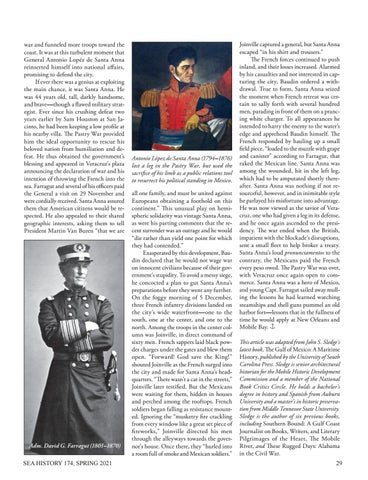war and funneled more troops toward the coast. It was at this turbulent moment that General Antonio Lopéz de Santa Anna reinserted himself into national affairs, promising to defend the city. If ever there was a genius at exploiting the main chance, it was Santa Anna. He was 44 years old, tall, darkly handsome, and brave—though a flawed military strategist. Ever since his crushing defeat two years earlier by Sam Houston at San Jacinto, he had been keeping a low profile at his nearby villa. The Pastry War provided him the ideal opportunity to rescue his beloved nation from humiliation and defeat. He thus obtained the government’s blessing and appeared in Veracruz’s plaza announcing the declaration of war and his intention of throwing the French into the sea. Farragut and several of his officers paid the General a visit on 29 November and were cordially received. Santa Anna assured them that American citizens would be respected. He also appealed to their shared geographic interests, asking them to tell President Martin Van Buren “that we are
Adm. David G. Farragut (1801–1870)
Antonio López de Santa Anna (1794–1876) lost a leg in the Pastry War, but used the sacrifice of his limb as a public relations tool to resurrect his political standing in Mexico. all one family, and must be united against Europeans obtaining a foothold on this continent.” This unusual play on hemispheric solidarity was vintage Santa Anna, as were his parting comments that the recent surrender was an outrage and he would “die rather than yield one point for which they had contended.” Exasperated by this development, Baudin declared that he would not wage war on innocent civilians because of their government’s stupidity. To avoid a messy siege, he concocted a plan to gut Santa Anna’s preparations before they went any further. On the foggy morning of 5 December, three French infantry divisions landed on the city’s wide waterfront—one to the south, one at the center, and one to the north. Among the troops in the center column was Joinville, in direct command of sixty men. French sappers laid black powder charges under the gates and blew them open. “Forward! God save the King!” shouted Joinville as the French surged into the city and made for Santa Anna’s headquarters. “There wasn’t a cat in the streets,” Joinville later testified. But the Mexicans were waiting for them, hidden in houses and perched among the rooftops. French soldiers began falling as resistance mounted. Ignoring the “musketry fire crackling from every window like a great set piece of fireworks,” Joinville directed his men through the alleyways towards the governor’s house. Once there, they “hurled into a room full of smoke and Mexican soldiers.”
Joinville captured a general, but Santa Anna escaped “in his shirt and trousers.” The French forces continued to push inland, and their losses increased. Alarmed by his casualties and not interested in capturing the city, Baudin ordered a withdrawal. True to form, Santa Anna seized the moment when French retreat was certain to sally forth with several hundred men, parading in front of them on a prancing white charger. To all appearances he intended to harry the enemy to the water’s edge and apprehend Baudin himself. The French responded by hauling up a small field piece, “loaded to the muzzle with grape and canister” according to Farragut, that raked the Mexican line. Santa Anna was among the wounded, hit in the left leg, which had to be amputated shortly thereafter. Santa Anna was nothing if not resourceful, however, and in inimitable style he parlayed his misfortune into advantage. He was now viewed as the savior of Veracruz, one who had given a leg in its defense, and he once again ascended to the presidency. The war ended when the British, impatient with the blockade’s disruptions, sent a small fleet to help broker a treaty. Santa Anna’s loud pronunciamentos to the contrary, the Mexicans paid the French every peso owed. The Pastry War was over, with Veracruz once again open to commerce. Santa Anna was a hero of Mexico, and young Capt. Farragut sailed away mulling the lessons he had learned watching steamships and shell guns pummel an old harbor fort—lessons that in the fullness of time he would apply at New Orleans and Mobile Bay. This article was adapted from John S. Sledge’s latest book, The Gulf of Mexico: A Maritime History, published by the University of South Carolina Press. Sledge is senior architectural historian for the Mobile Historic Development Commission and a member of the National Book Critics Circle. He holds a bachelor’s degree in history and Spanish from Auburn University and a master’s in historic preservation from Middle Tennessee State University. Sledge is the author of six previous books, including Southern Bound: A Gulf Coast Journalist on Books, Writers, and Literary Pilgrimages of the Heart, The Mobile River, and These Rugged Days: Alabama in the Civil War.
SEA HISTORY 174, SPRING 2021 29
